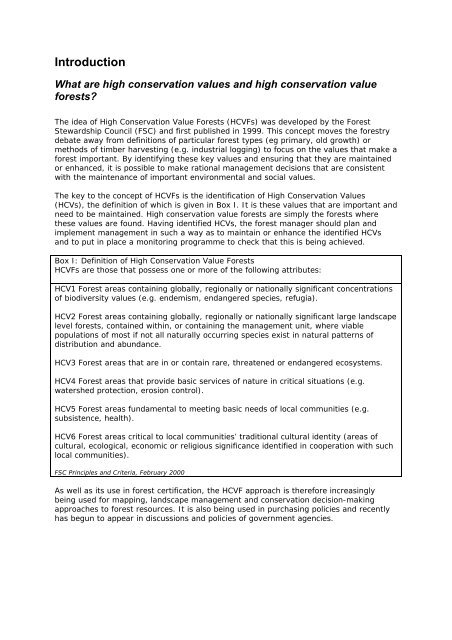English - HCV Resource Network
English - HCV Resource Network
English - HCV Resource Network
You also want an ePaper? Increase the reach of your titles
YUMPU automatically turns print PDFs into web optimized ePapers that Google loves.
Introduction<br />
What are high conservation values and high conservation value<br />
forests?<br />
The idea of High Conservation Value Forests (<strong>HCV</strong>Fs) was developed by the Forest<br />
Stewardship Council (FSC) and first published in 1999. This concept moves the forestry<br />
debate away from definitions of particular forest types (eg primary, old growth) or<br />
methods of timber harvesting (e.g. industrial logging) to focus on the values that make a<br />
forest important. By identifying these key values and ensuring that they are maintained<br />
or enhanced, it is possible to make rational management decisions that are consistent<br />
with the maintenance of important environmental and social values.<br />
The key to the concept of <strong>HCV</strong>Fs is the identification of High Conservation Values<br />
(<strong>HCV</strong>s), the definition of which is given in Box I. It is these values that are important and<br />
need to be maintained. High conservation value forests are simply the forests where<br />
these values are found. Having identified <strong>HCV</strong>s, the forest manager should plan and<br />
implement management in such a way as to maintain or enhance the identified <strong>HCV</strong>s<br />
and to put in place a monitoring programme to check that this is being achieved.<br />
Box I: Definition of High Conservation Value Forests<br />
<strong>HCV</strong>Fs are those that possess one or more of the following attributes:<br />
<strong>HCV</strong>1 Forest areas containing globally, regionally or nationally significant concentrations<br />
of biodiversity values (e.g. endemism, endangered species, refugia).<br />
<strong>HCV</strong>2 Forest areas containing globally, regionally or nationally significant large landscape<br />
level forests, contained within, or containing the management unit, where viable<br />
populations of most if not all naturally occurring species exist in natural patterns of<br />
distribution and abundance.<br />
<strong>HCV</strong>3 Forest areas that are in or contain rare, threatened or endangered ecosystems.<br />
<strong>HCV</strong>4 Forest areas that provide basic services of nature in critical situations (e.g.<br />
watershed protection, erosion control).<br />
<strong>HCV</strong>5 Forest areas fundamental to meeting basic needs of local communities (e.g.<br />
subsistence, health).<br />
<strong>HCV</strong>6 Forest areas critical to local communities’ traditional cultural identity (areas of<br />
cultural, ecological, economic or religious significance identified in cooperation with such<br />
local communities).<br />
FSC Principles and Criteria, February 2000<br />
As well as its use in forest certification, the <strong>HCV</strong>F approach is therefore increasingly<br />
being used for mapping, landscape management and conservation decision-making<br />
approaches to forest resources. It is also being used in purchasing policies and recently<br />
has begun to appear in discussions and policies of government agencies.

















